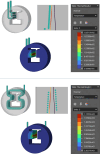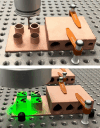Optimizing a photon absorber using conformal cooling channels and additive manufacturing in copper
- PMID: 40358981
- PMCID: PMC12236252
- DOI: 10.1107/S1600577525003078
Optimizing a photon absorber using conformal cooling channels and additive manufacturing in copper
Abstract
Many of the 70 synchrotron facilities worldwide are undergoing upgrades to their infrastructure to meet a growing demand for increased beam brightness with nanometre-level stability. These upgrades increase the mechanical and thermal challenges faced by beamline components, creating opportunities to apply novel methodologies and manufacturing processes to optimize hardware performance and beam accuracy. Absorbers are important beamline components that rely on water-cooled channels to absorb thermal energy from excess light caused by synchrotron radiation or photon beams created by insertion devices, all within a limited volume, to protect downstream equipment and ensure safe, reliable operation. Additive manufacturing (AM) has been shown to meet criteria relevant to synchrotron environments like leak tightness and vacuum compatibility. However, there is a research gap on the heat transfer and pressure drop impact of different AM conformal cooling channel geometries, as well as the print quality of AM copper parts using low-power infrared lasers and their compliance with absorber requirements. In this study, an intermediate model of a Diamond Light Source photon absorber was optimized to incorporate AM conformal cooling channels, leading to two concept designs named `Horizontal' and `Coil'. When compared with the baseline design, the lightweight Horizontal concept performed the best in this study, with simulations showing a maximum temperature drop of 11%, a calculated pressure drop reduction of 82%, a mass reduction of 86%, and the consolidation of 21 individually brazed pipes into a single manifold. The AM print quality and compliance with the synchrotron environment was examined by producing custom benchmark artefacts and measuring their surface roughness, dimensional accuracy and porosity levels, which are characteristics that can affect heat absorption, structural integrity, thermal conductivity and vacuum performance. The study demonstrates the benefits and addresses outstanding challenges in reducing thermal fatigue, as well as the size, vibrations and energy consumption of AM absorbers.
Keywords: 3D printing; additive manufacturing; heat transfer; particle accelerator; pressure drop.
open access.
Figures




















References
-
- Biffi, C. A., Fiocchi, J., Boldrini, S. & Tuissi, A. (2024). Lasers Manuf. Mater. Process.11, 143–153.
-
- Cengel, Y. (2004). Heat Transfer: A Practical Approach. McGraw-Hill Education (https://books.google.co.uk/books?id=xYASMQAACAAJ).
-
- Cengel, Y. & Cimbala, J. (2013). Fluid Mechanics Fundamentals and Applications, 3rd ed. McGraw-Hill US Higher Education (https://books.google.co.uk/books?id=QZIjAAAAQBAJ).
-
- Çengel, Y. & Ghajar, A. (2015). Heat and Mass Transfer: Fundamentals and Applications, Asia Higher Education Engineering/Computer Science Mechanica. McGraw Hill Education (https://books.google.co.uk/books?id=1YPhoAEACAAJ).
Grants and funding
LinkOut - more resources
Full Text Sources
Miscellaneous

